Telescope Books
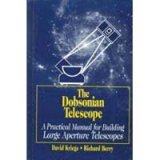 The Dobsonian Telescope: A Practical Manual for Building Large Aperture Telescopes
The Dobsonian Telescope: A Practical Manual for Building Large Aperture Telescopes
This book tells how you can build a state-of-the-art Dobsonian telescope using readily available materials and supplies. Every step of construction is detailedin photographs and diagrams, and the underlying ideas are carefully explained. Yyou now have the opportunity to build a high-performance telescope from 14 inches to 40 inches aperture based on the thoroughly tested designs described in this book.
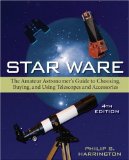 Star Ware: The Amateur Astronomer’s Guide to Choosing, Buying, and Using Telescopes and Accessories
Star Ware: The Amateur Astronomer’s Guide to Choosing, Buying, and Using Telescopes and Accessories
In this revised and updated Fourth Edition of the essential guide to comparing and selecting sky-watching equipment, award-winning astronomy writer Philip Harrington takes you telescope shopping the easy way. He analyzes and explains today’s astronomy market and compares brands and models point by point. Star Ware gives you the confidence you need to buy the telescope and accessories that are right for you and the knowledge to get the most out of your new purchase, with:
- Extensive, expanded reviews of leading models and accessories-including dozens of new products
- clear, step-by-step guide to every aspect of selecting telescopes, binoculars, filters, mounts, lenses, cameras, film, star charts, guides and references, and much more
- Ten new do-it-yourself projects for building your own astronomical equipment
- Easy tips on setting up, using, and caring for telescopes and other astronomical equipment
- Lists of where to find everything astronomical, including Web sites and resources; distributors, dealers, and conventions; and corporate listings for products and services
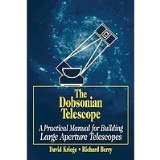
The Dobsonian Telescope: A Practical Manual for Building Large Aperture Telescopes
This book tells how you can build a state-of-the-art Dobsonian telescope using readily available materials and supplies. Every step of construction is detailedin photographs and diagrams, and the underlying ideas are carefully explained. As a result of this three-year collaboration between authors David Kriege and Richard Berry, experienced and well-known telescope makers, you now have the opportunity to build a high-performance telescope from 14 inches to 40 inches aperture based on the thoroughly tested designs described in this book. The Dobsonian telescope takes its name from the astronomer/philosopher John Dobson, who introduced the concept of inexpensive, large-aperture telescopes to astronomy. Amateur astronomers at the time were so amazed that a telescope builtfrom simple, inexpensive materials performed so well that they could hardly believe their eyes. As home-built Dobsonians started showing up at star parties across the nation and people saw what Dobsonians could do, the word spread. In just a few years, the Dobsonian revolution swept the world. Since those early telescopes, Dobsonians have improved dramatically. An entire generation of amateur telescope makers contributed their best insights and refinements to Dobson’s original design. Today’s Dobsonians are larger, lighter,and more precise than ever before.
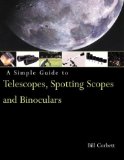
A Simple Guide to Telescopes, Spotting Scopes and Binoculars
The world of telescopes, spotting scopes, and binoculars can be quite daunting to the uninitiated. Part buyer’s guide, part instruction manual, this one-of-a-kind reference sorts out all the essential details. Not only will readers receive a foundation in such basics as telescope types, accessories, adjustments, and maintenance, they’ll also discover tested techniques for successful viewing at sporting events, viewing landscapes and terrain, as well as basic star gazing. Finally, star charts and other astronomy references show readers how to navigate around the heavens and photograph specific objects in the night sky.
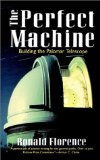 The Perfect Machine: Building the Palomar Telescope
The Perfect Machine: Building the Palomar Telescope
Almost a half-century after is completion, the 200-inch Palomar telescope remains an unparalleled combination of vast scale and microscope detail. As huge as the Patheon of Rome and as heavy as the Statue of Liberty, this magnificent instrument is so precisely built that its seventeen-foot mirror was hand-polished to a tolerance of 2/1,000,000 of an inch. The telescope’s construction drove some to the brink of madness, made others fearful that mortals might glimpse heaven, and transfixed an entire nation. Ronald Florence weaves into his account of the creation of “the prefect machine” a stirring chronicle of ht birth of Big Science and a poignant rendering of an America mired in the depression yet reaching for the stars.
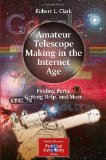
Amateur Telescope Making in the Internet Age: Finding Parts, Getting Help, and More (Patrick Moore’s Practical Astronomy Series)
Building an astronomical telescope offers the amateur astronomer an exciting challenge, with the possibility of ending up with a far bigger and better telescope than could have been afforded otherwise. In the past, the starting point has always been the grinding and polishing of at least the primary mirror, a difficult and immensely time-consuming process. But now that the Internet has brought us together in a global village, purchasing off-the-shelf goods such as parabolic mirrors, eyepieces, lenses, and telescope tubes, is possible. There are also a vast number of used mirrors and lenses out there, and it is now possible to track them down almost anywhere in the world. Online stores and auction houses have facilitated commerce regarding all sorts of useful optical components at a reasonable price. This is a book about making telescopes from available parts. It provides guidance on where to look and what to look for in selecting items useful for telescope making and explains how to assemble these components to produce an excellent instrument on a tight budget. At one time, many amateurs made their own telescopes from home-made parts. In today’s rushed world, that has almost become a lost art. The Internet offers a wonderful alternative to either buying a pricey scope fully assembled or making your own from scratch.
